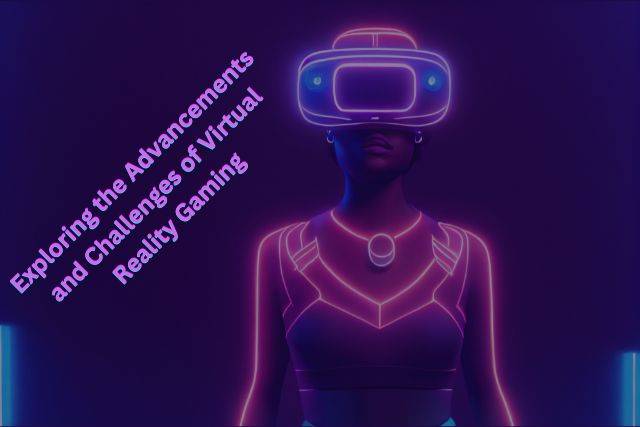Introduction
A computer-generated simulation of a three-dimensional environment called virtual reality (VR) allows users to interact with it using specialised tools like a VR headset. VR technology has been around for decades, but it has only recently started to gain mainstream popularity, particularly in the gaming industry. The use of VR technology in gaming promises an immersive experience that allows players to fully engage with the game’s environment and characters.
In this outline, we will exploring the advancements and challenges of virtual reality gaming, the impact of virtual reality on the gaming industry, and the potential applications of virtual reality beyond gaming.
Advancements in virtual reality technology
- Hardware: Virtual reality headsets have undergone significant improvements in recent years. High-end VR headsets such as the Oculus Rift, HTC Vive, and PlayStation VR offer high resolution displays, improved field of view, and increased comfort. Additionally, VR controllers have also evolved to provide more accurate and precise motion tracking, allowing for a more immersive gaming experience.
- Software and Graphics: VR technology has also seen advancements in software and graphics. Developers are now able to create more realistic and detailed virtual environments, which greatly enhances the immersion factor in VR gaming. Additionally, new software development kits (SDKs) have been introduced that allow for the creation of multi-player VR games, which opens up new possibilities for social VR experiences.
- New forms of interaction: VR technology has also led to the development of new forms of interaction, such as hand tracking and finger tracking. These new forms of interaction enable players to interact with the virtual environment in a more natural and intuitive way, which can greatly enhance the immersion factor in VR gaming.
- Wireless VR: new VR headsets are coming to the market that are wireless, making the experience more comfortable and immersive. These headsets use technologies such as 5G, or Wi-Fi 6, to deliver the virtual environment to the headset with minimal latency.
- Standalone VR: Standalone VR headsets have been introduced that don’t require a PC or a console to operate, making them more accessible to a wider audience. These headsets have their own built-in processors, storage, and batteries, which eliminate the need to connect to an external device.
- Audio: Audio is an essential part of the VR experience. Advancements in audio technology have led to the development of 3D audio, which creates a more realistic sound environment and increases immersion in VR games.
These advancements have made VR technology more accessible, more comfortable and more immersive, which has led to a growing interest in VR gaming.
Challenges facing virtual reality gaming
- Cost: One of the main challenges facing virtual reality gaming is the cost of the equipment. High-end VR headsets and controllers can be quite expensive, making it difficult for some individuals to afford. This can limit the number of people who are able to experience VR gaming.
- Technical limitations: Another challenge facing VR gaming is technical limitations, such as motion sickness. Some players may experience discomfort or nausea while using VR headsets, which can be caused by factors such as low frame rates or high latency.
- Limited content availability: A lack of available VR-compatible games and experiences is another challenge facing the VR gaming industry. While the number of VR-compatible games is increasing, it is still relatively small compared to the number of non-VR games available.
- Hardware compatibility: VR gaming requires a powerful PC or console, and not all devices are compatible with VR headsets. This can be a challenge for those who don’t have access to a compatible device, making it difficult for them to experience VR gaming.
- Spatial awareness: VR games require players to be aware of the physical space around them, this can be challenging for some people, especially for children, who may not have developed the spatial awareness required for VR gaming.
- Social isolation: Virtual reality gaming can be a solitary experience, and some people may find it less social than traditional gaming. This may be a challenge for those who prefer to play with friends or family.
- Long-term use: prolonged use of VR headset may cause eye strain, headaches and other physical discomforts. This can be a challenge for those who want to play VR games for long periods of time.
- Cyber sickness: Some people may experience symptoms such as nausea, headaches, and vertigo when using virtual reality technology, known as Cyber sickness. This can make it difficult for some individuals to enjoy VR gaming.
These challenges can limit the potential reach of VR gaming and prevent it from reaching its full potential. However, as VR technology continues to improve, it is likely that these challenges will be overcome.
Virtual reality’s effects on the gaming sector
- Immersive experience: Virtual reality technology has the potential to create an immersive gaming experience that is unparalleled by traditional gaming. VR technology allows players to fully engage with the game’s environment and characters, creating a more realistic and immersive experience.
- New forms of gameplay: Virtual reality technology has also led to the development of new forms of gameplay, such as hand and finger tracking, which enable players to interact interacting more easily and naturally with the virtual world. This can greatly enhance the immersion factor in VR gaming and open up new possibilities for game design.
- Increased revenue: Virtual reality technology has the potential to increase revenue for the gaming industry. As VR technology becomes more accessible and affordable, more people will be able to experience VR gaming, which can lead to increased sales of VR-compatible games and hardware.
- Development of new genres: Virtual reality technology has the potential to create new genres of games that are not possible with traditional gaming. For example, VR technology can be used to create games that simulate real-world experiences, such as flying a plane or performing surgery.
- Impact on the economy: Virtual reality technology can have a significant impact on the economy, creating new jobs and industries related to VR gaming, such as VR game development, VR content creation, and VR hardware manufacturing.
- Accessibility: Virtual reality technology has the potential to make gaming more accessible to people with disabilities, such as the visually impaired or those with mobility impairments.
- Impact on traditional gaming: Virtual reality technology has the potential to change the way traditional games are played and designed. This can lead to the development of new types of games that incorporate VR technology, such as virtual reality escape rooms, virtual reality sports games, or virtual reality interactive storytelling.
- Impact on other industries: Virtual reality technology has the potential to impact other industries, such as tourism, education, and healthcare, by providing new ways to experience and interact with virtual environments.
Overall, virtual reality technology has the potential to greatly impact the gaming industry and change the way we play and experience games.
Applications of virtual reality beyond gaming
- Education: Virtual reality technology can be used in education to create immersive and interactive learning experiences. For example, VR technology can be used to create virtual field trips, simulations of historical events, or virtual dissection of the human body.
- Healthcare: Virtual reality technology can be used in healthcare to provide patients with exposure therapy for conditions such as phobias, post-traumatic stress disorder (PTSD), and chronic pain. VR technology can also be used to train medical professionals in a safe, simulated environment.
- Architecture and Interior Design: Virtual reality technology can be used to create virtual walkthroughs of buildings and interiors, allowing architects and designers to visualize their designs in a realistic, three-dimensional environment.
- Travel and Tourism: Virtual reality technology can be used to create virtual tours of tourist destinations, allowing people to experience a destination before they actually travel there.
- Training and Simulation: Virtual reality technology can be used to create realistic simulations for training purposes, such as in the military, aviation, and emergency services. This can help trainees to acquire the skills they need in a safe, controlled environment.
- Entertainment: Virtual reality technology can be used to create immersive and interactive entertainment experiences, such as virtual reality movies, theme parks, and escape rooms.
- Art: Virtual reality technology can be used to create interactive and immersive art experiences, such as virtual reality installations, virtual reality music videos, or virtual reality museum exhibits.
- Mental Health: Virtual Reality technology can be used to help patients with mental disorders such as anxiety, depression, and PTSD. By immersing patients in a virtual environment, they can be exposed to the source of their disorder in a controlled way, thus allowing them to learn how to cope with it.
These are just a few examples of the many potential applications of virtual reality technology beyond gaming. As VR technology continues to improve, new uses and applications are likely to emerge.
Conclusion
In conclusion, virtual reality technology has the potential to greatly impact the gaming industry by creating more immersive and interactive gaming experiences. Additionally, VR technology has a wide range of applications beyond gaming, such as education, healthcare, architecture, tourism, training, and entertainment.
The use of VR technology has the potential to change the way we interact with and experience the world around us. However, despite the potential benefits, there are also challenges facing virtual reality technology, such as cost, accessibility, and the need for further research and development. Therefore, it is important to continue to invest in and support the development of VR technology in order to fully realize its potential and bring its benefits to as many people as possible.



